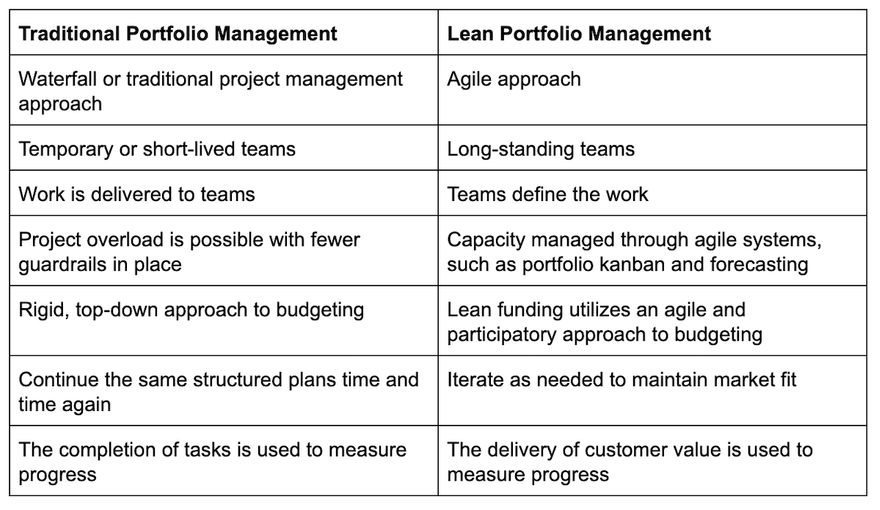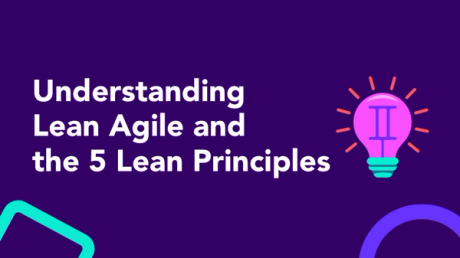Agile workflow
6 min read

Lean Portfolio Management: Aligning Work With Funding
Thu Jun 03 2021
Applying lean principles to portfolio development helps businesses close the gap between the teams actually doing the work and the teams that allocate the funding. Lean portfolio management (LPM) connects strategy to execution, ensuring agile development aligns with business strategy, all the while focusing on value delivery.
Today’s businesses need to adapt and evolve faster than ever before. As the world changes, technology advances, and customers demand more, businesses are left scrambling to make quick shifts to business plans.
The problem is many businesses are not set up to make adjustments quickly, and it’s especially difficult for larger enterprises to succeed at an agile transformation. The systems that are in place are often rigid, and when an adjustment is needed, it can take months or even years for the whole organization to get up to speed.
Lean development offers a clear application for scaling agile practices across large enterprises and growing organizations.
Continue reading to learn how lean principles are utilized in lean portfolio management to establish an aligned enterprise strategy. We’ll cover the 5 lean principles, how LPM compares to traditional portfolio management, and the critical (scalable!) benefits that lean portfolio management provides enterprises.
What is lean portfolio management (LPM)?
Agile methodologies help businesses of all shapes and sizes adapt to changing situations, but these methods don’t always transfer gracefully over to large enterprises or businesses that are growing at a fast pace.
To keep pace, large businesses can use the Scaled Agile Framework (SAFe) and transition to lean portfolio management in order to better serve investors, stakeholders, devops teams, and customers.
Lean portfolio management applies lean principles to portfolio operations, including strategies that allocate funds, monitor risk tolerance, prioritize investment funds, and optimize ROI. This type of portfolio management aims to maximize value delivery, prevent bottlenecks, and balance capacity and high value opportunities.
Let’s start with the 5 leading principles of lean used in LPM.
The 5 principles of lean
Lean software development, or lean agile, was inspired by the principles of lean manufacturing and enables operational excellence. The idea is simple: Eliminate waste and improve efficiency.
The concept developed as a way for manufacturing businesses to improve business outcomes and profits in other ways than relying on sales alone. By reducing costs and becoming more efficient, a business can improve the bottom line.
The five principles of lean are:
- Identify value
- Map the value stream
- Create flow
- Establish a pull system
- Seek perfection
💰 Identify value
To identify value, you must step into the shoes of the customer. Value is what the customer wants or needs from your product. A project cannot move forward without clearly identifying how to provide customer satisfaction.
🗺 Map the value stream
Visually map each of the steps and processes it will take to bring the product from inception to delivery. It’s easier to see the steps that do not directly contribute value when you make each of them visible and keep the value front and center. Once the wasteful steps are found, the team can eliminate or reduce them to ensure funding isn’t needlessly spent on the steps that don’t add value to the customer.
🌊 Create flow
The next principle makes sure the remaining processes work as effectively and efficiently as possible. The steps that create value must work in tight sequences to ensure the product flows smoothly toward the customer with no disruptions, delays, or bottlenecks. To achieve this, lean businesses must train their employees to practice adaptive decision making, create cross-functional teams, rearrange and reset production steps, and balance employee workloads.
💪 Establish a pull system
Implementing a pull system enables “just-in-time” (JIT) manufacturing and delivery. It limits inventory and work-in-progress (WIP) items so you only produce what’s required to meet customer demand. This spares you from unneeded inventory costs.
🏆 Seek perfection
The work is never done. Lean takes time to implement, and only going through the process once isn’t enough. Build a continuous improvement mindset into your company culture to ensure you never grow complacent and allow the status quo to take hold.
Traditional portfolio management vs. lean portfolio management
Traditional portfolio management is based on establishing structured plans and systems the organization rigidly sticks to. It was used long before the global economy and digital systems disrupted the ways people work.
Lean portfolio management, on the other hand, aligns business strategy with execution in order to improve business agility. This improved agility means businesses can react more quickly and apply new information across the enterprise throughout the process instead of adhering to the same old practices.
Traditional portfolio management and lean portfolio management both allocate funds and govern spending, but the strategy for how that is done is quite different.

The essential benefits of lean portfolio management
Lean portfolio management targets key pain points enterprises face, such as focusing on task completion over delivering customer value. Lean portfolio managers can limit dependencies, and lean principles help agile teams implement an approach that can evolve based on stakeholder feedback, customer needs, and new information.
Critical benefits of adopting lean principles for portfolio management:
- Funding allocation decisions are made based on the most recent information and metrics.
- Having teams (or groups of teams) define the work throughout the process reduces the disconnect between the people who do the work and the people who fund the work.
- Long-standing teams can address real issues instead of moving from one short-term project to the next.
- Portfolio performance is improved as the portfolio leadership team aims to continually fine-tune processes.
- A smooth portfolio flow is established as team communication improves.
- The portfolio vision can evolve as stakeholders give feedback and customer needs are realized.
- Bottlenecks are limited since capacity and WIP are continually forecasted, monitored, and adjusted.
- The approach targets the highest-value opportunities to increase the delivery of value to the marketplace.
- Customer needs are continually considered as value delivery is the measurement of progress.
The fast pace of business won’t likely slow down. It’s critical for businesses of all sizes to establish systems that allow for adaptability. Things that can’t bend break, which is why many enterprises are turning to lean approaches that align the entire business rather than just one team at a time.
Improve your agile processes with Easy Agile
Our team is committed to helping businesses, startups, and large scale enterprises improve their agile processes. Easy Agile Jira plugins help business owners, product owners, product managers, Scrum Masters, and development teams align around goals and customer needs.
Our agile apps for Jira are simple, collaborative, and flexible. From team agility with Easy Agile TeamRhythm, to scaled agility with Easy Agile Programs, our apps can help your agile teams work better together, and deliver for your customers.
Book a 1:1 demo to learn more about our suite of Jira tools, or contact our team if you have additional questions. We offer a free, 30-day trial, so you can try out our products before making a commitment.



